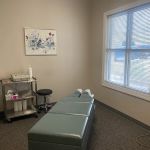
- 1 - What Is Frozen Shoulder?
- 2 - Causes of Frozen Shoulder
- 3 - Chiropractor Recommendations for Frozen Shoulder Relief
- 4 - Exercises and Stretches for Frozen Shoulder
- 5 - Alternative Treatments for Frozen Shoulder
- 6 - When to See a Chiropractor for Frozen Shoulder
1 - What Is Frozen Shoulder?
Frozen shoulder, also known as adhesive capsulitis, is a condition characterized by stiffness, pain, and limited range of motion in the shoulder joint. The condition typically develops gradually and can severely impact the ability to perform everyday activities, such as lifting objects, reaching overhead, or even sleeping comfortably. Frozen shoulder can affect anyone, but it is more common in people between the ages of 40 and 60, and it tends to be more prevalent in women.
The condition progresses in three phases: the freezing phase (pain and stiffness), the frozen phase (stiffness with less pain), and the thawing phase (gradual improvement in movement). While the exact cause of frozen shoulder is not fully understood, it is often associated with shoulder injuries, surgery, or underlying medical conditions such as diabetes, thyroid disorders, or heart disease.
2 - Causes of Frozen Shoulder
Frozen shoulder typically occurs when the connective tissue surrounding the shoulder joint, known as the capsule, becomes inflamed and thickened. This inflammation leads to a restriction in movement and can cause severe discomfort. While the precise cause is not always clear, there are several factors that increase the likelihood of developing frozen shoulder:
- Previous Shoulder Injuries: Injuries to the shoulder, such as fractures, rotator cuff tears, or dislocations, can trigger the development of frozen shoulder, especially if the shoulder is immobilized for an extended period of time.
- Medical Conditions: People with certain medical conditions, such as diabetes, heart disease, or thyroid issues, are at higher risk of developing frozen shoulder. These conditions may contribute to changes in the connective tissue surrounding the joint.
- Prolonged Inactivity: Keeping the shoulder immobile for extended periods, often due to surgery or other medical conditions, can contribute to the development of frozen shoulder.
- Aging: As people age, the risk of developing frozen shoulder increases, especially after the age of 40. The body’s natural healing processes may slow down, making the connective tissue more prone to stiffness and inflammation.
Understanding the underlying causes of frozen shoulder is crucial in determining the most effective course of treatment and finding the right approach for relief.
3 - Chiropractor Recommendations for Frozen Shoulder Relief
Chiropractors are often sought after for frozen shoulder relief due to their expertise in musculoskeletal conditions and natural approaches to healing. Chiropractors employ various techniques to address the root causes of frozen shoulder and alleviate pain and stiffness in the shoulder joint. Some of the key chiropractic recommendations include:
- Spinal Manipulation: Chiropractic spinal manipulation can help improve overall mobility and function. By realigning the spine and improving the nervous system’s communication, chiropractors aim to reduce inflammation and pain in the shoulder joint.
- Joint Mobilization: Chiropractors often use joint mobilization techniques to gently move the shoulder joint within its range of motion. This technique helps reduce stiffness and improve flexibility, allowing the shoulder to regain movement over time.
- Soft Tissue Therapy: Chiropractors may use massage therapy or other soft tissue techniques to relax tight muscles around the shoulder. This can help relieve tension and improve circulation to the area, promoting healing.
- Exercise and Stretching Programs: Chiropractors often design personalized exercise and stretching routines for patients with frozen shoulder. These exercises help improve flexibility, restore strength, and prevent the recurrence of stiffness.
Chiropractic care focuses on addressing the underlying causes of frozen shoulder and providing long-term relief by improving mobility, reducing pain, and supporting the body’s natural healing processes.
4 - Exercises and Stretches for Frozen Shoulder
One of the most effective ways to manage frozen shoulder and promote recovery is through targeted exercises and stretches. Chiropractors and physical therapists often recommend specific exercises designed to improve the shoulder’s range of motion and strengthen the muscles around the joint. Some helpful exercises include:
- Pendulum Stretch: This exercise involves standing and letting the affected arm hang down while gently swinging it in small circles. This helps to improve circulation and reduce stiffness in the shoulder joint.
- Cross-Body Stretch: To perform this stretch, bring your affected arm across your body, using your other hand to gently pull your elbow toward the opposite shoulder. This stretch helps to increase flexibility in the shoulder joint.
- Wall Climb: Stand facing a wall with your fingertips touching the wall. Slowly “climb” the wall with your fingers, moving your arm upward while keeping your elbow straight. This exercise helps improve range of motion and flexibility.
- External Rotation Stretch: Bend your elbow at a 90-degree angle and hold a stick or towel with both hands. Gently rotate your affected arm outward, working to increase the range of motion in the shoulder.
Performing these exercises regularly can help alleviate pain, improve mobility, and promote long-term recovery from frozen shoulder.
5 - Alternative Treatments for Frozen Shoulder
While chiropractic care and exercise play an essential role in managing frozen shoulder, other alternative treatments may complement these approaches. Some additional treatments include:
- Acupuncture: Acupuncture can help relieve pain and promote healing by stimulating specific points on the body. Some individuals find that acupuncture helps reduce inflammation and increases circulation to the shoulder joint.
- Heat and Cold Therapy: Applying heat or cold to the shoulder can provide relief from pain and reduce inflammation. Heat therapy can relax tight muscles, while cold therapy can reduce swelling.
- Hydrotherapy: Immersing the shoulder in warm water can help relax muscles and reduce stiffness. Gentle movements in warm water can also promote range of motion and alleviate discomfort.
These alternative treatments can be effective additions to chiropractic care, helping speed up the recovery process and further alleviate pain associated with frozen shoulder.
6 - When to See a Chiropractor for Frozen Shoulder
If you’re dealing with frozen shoulder and experiencing persistent pain or limited movement, it may be time to consult a chiropractor. A chiropractor can assess your condition, recommend appropriate treatments, and develop a personalized plan to help you regain mobility and reduce pain. If you notice any of the following signs, it’s time to seek chiropractic care:
- Ongoing Pain: If pain persists or becomes more severe despite basic stretching and rest, a chiropractor can help address the underlying issues.
- Limited Range of Motion: If you notice significant difficulty in moving your shoulder or performing everyday tasks, chiropractic care may help restore mobility.
- Failure to Improve: If you’ve tried other treatments with minimal progress, a chiropractor can offer specialized therapies to speed up recovery.
By addressing frozen shoulder early and incorporating chiropractic care into your treatment plan, you can enjoy lasting relief and improved mobility.
If you're looking for professional chiropractic care for frozen shoulder, visit ChiroScope to find the best chiropractor and additional services that can help you recover quickly and effectively.







 Center for Chiropractic Rehabilitation & Wellness, LLC5.0 (71 reviews)
Center for Chiropractic Rehabilitation & Wellness, LLC5.0 (71 reviews) Hands That Heal Chiropractic, LLC4.0 (26 reviews)
Hands That Heal Chiropractic, LLC4.0 (26 reviews) Michael W. Phillips, DC4.0 (7 reviews)
Michael W. Phillips, DC4.0 (7 reviews) Acute Care Chiropractic Clinic4.0 (22 reviews)
Acute Care Chiropractic Clinic4.0 (22 reviews) Carolina Spine and Injury4.0 (22 reviews)
Carolina Spine and Injury4.0 (22 reviews) Dubec, Tiffany D.C.- Adjust 2 Life Chiropractic and Wellness0.0 (0 reviews)
Dubec, Tiffany D.C.- Adjust 2 Life Chiropractic and Wellness0.0 (0 reviews) How Chiropractic Care Helps with Post-Concussion Syndrome Recovery
How Chiropractic Care Helps with Post-Concussion Syndrome Recovery Expert Tips for Managing Chiropractic Safety Naturally with Chiropractic Care
Expert Tips for Managing Chiropractic Safety Naturally with Chiropractic Care What Causes Chiropractic and Mental Health and How Chiropractors Treat It
What Causes Chiropractic and Mental Health and How Chiropractors Treat It How to Relieve Chiropractic Myths Without Medication – Chiropractor Approved
How to Relieve Chiropractic Myths Without Medication – Chiropractor Approved Chiropractic Advice for Back Pain Relief You Can Start Today
Chiropractic Advice for Back Pain Relief You Can Start Today The Connection Between Chiropractic Care and Enhanced Immune Function
The Connection Between Chiropractic Care and Enhanced Immune Function